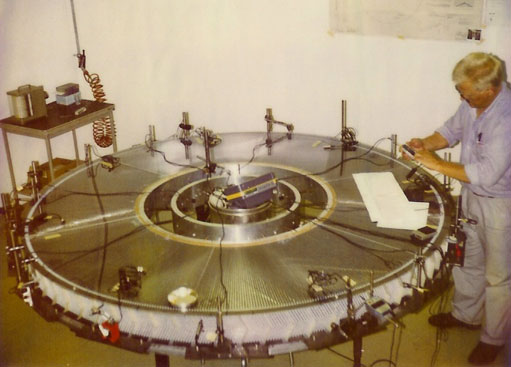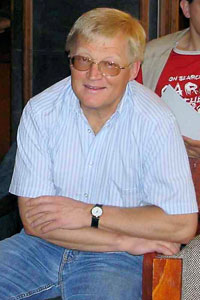
ATLAS e-News
23 February 2011
In memoriam: Sergei Mouraviev
5 October 2009

A familiar scene with Sergei hard at work on a TRT wheel prototype when this project was known as RD6 back in 1994
As a student of Moscow Engineering and Physics Institute (MEPhI) Sergei Mouraviev already worked in a laboratory on the construction of liquid Xenon detectors.
He graduated as engineer-physicist in 1976 and entered the Lebedev Institute of Physics of the Russian Academy of Sciences. From then till his death, Sergei was a member of MEPhI-Lebedev experimental team under the leadership of Boris Dolgoshein. He participated in all their projects and experiments.
A total-absorption spectrometer made of liquid Xenon (40 liters) was finally completed, with all operating devices (gas and Xenon purification system, high voltage power supply etc), successfully tested at the Serpukhov Accelerator at 70 GeV. This was Sergei’s PhD work and by then he became an expert on noble gas detectors. But there was no experiment found to use this 40 liters Xe spectrometer.
Sergei was invited for one year to Budker Institute of Nuclear Physics in Novosibirsk to help them develop, construct and test prototypes using liquid Xe and Kr. They were very satisfied with his work. There were two papers published.
Back in Moscow Sergei participated in preparing the detector for NA34 (HELIOS) experiment at CERN. NA34 was conceived to address electron and muon production in pp collisions using the SPS beam. The MEPhI-Lebedev team, starting in 1975, worked to create Transition Radiation Detectors (TRD) for physics. In 1979-80, following an invitation from Prof. William Willis, the Russian team made a methodical experiment on SPS to investigate the new method of cluster counting for the TRDs. The result was successful. The need to identify electrons in NA34 experiment led to having the MEPhI-Lebedev team take complete responsibility for the TRD detector for NA34.

Sergei attending the TRT meeting, held in Dubna, May 2005
Sergei was one of the leading Moscow physicists during the construction of the HELIOS TRD in Russia and during the experiment at CERN. He arrived at CERN for the first time in 1986. Ten papers were published on the NA34 physics results and on the instrumental aspects of the NA34 TRD. The TRD was estimated to be worth 600 KCHF. By this time Sergei had gotten a lot of knowledge about many aspects of constructing and functioning of noble gas and liquid detectors. He could independently deal with and resolve any problem when working with these detectors.
During the collaboration between CERN and MEPhI-Lebedev team on Transition Radiation, several major advances (e.g. cluster counting, “fine sampling TRDs) led to a proposal to use transition radiation for electron identification at future high luminosity colliders (SSC, LHC). Once the conceptual feasibility was established, the RD6 collaboration was set up in 1989 to demonstrate the new detector concept, the “Transition Radiation Tracker” (TRT), which provides electron identification, and precision momentum information. The new performance of the detection elements, so called “straws” (4 mm drift tubes), was proposed. In RD6 the Russian institutes have taken major responsibilities on most detector aspects, except for electronics. Other institutes joined RD6 and started the work to create the TRT detector for the ATLAS experiment. Sergei Mouraviev was responsible for the design of TRT prototypes and their investigation at CERN.
After the end-cap wheels for the TRT completed in Gatchina and Dubna, Sergei was responsible for all Quality Assurance tests of all wheels arriving from Russia. For this task, six wheel test stations were created at CERN, mostly according to Sergei’s ideas. All the information about every single 420 000 straws in the TRT end-caps was recorded in the ATLAS Data Base.
Sergei was hard working and a very nice person. Everybody could always count on him for help or advice, often time very inventive. His colleagues will greatly miss him.
Alevtina ShmelevaP.N. Lebedev Institute of Physics (FIAN)
|